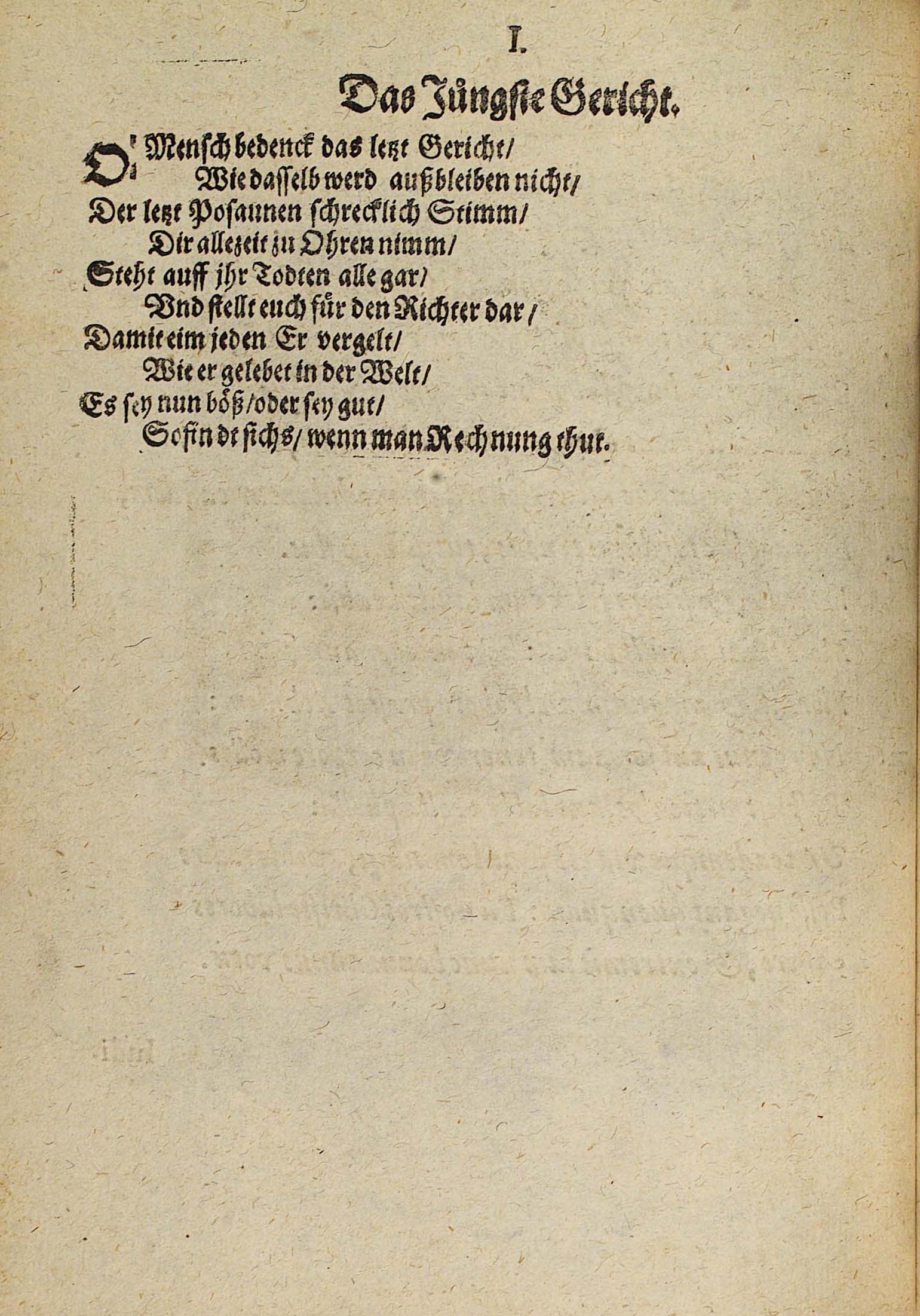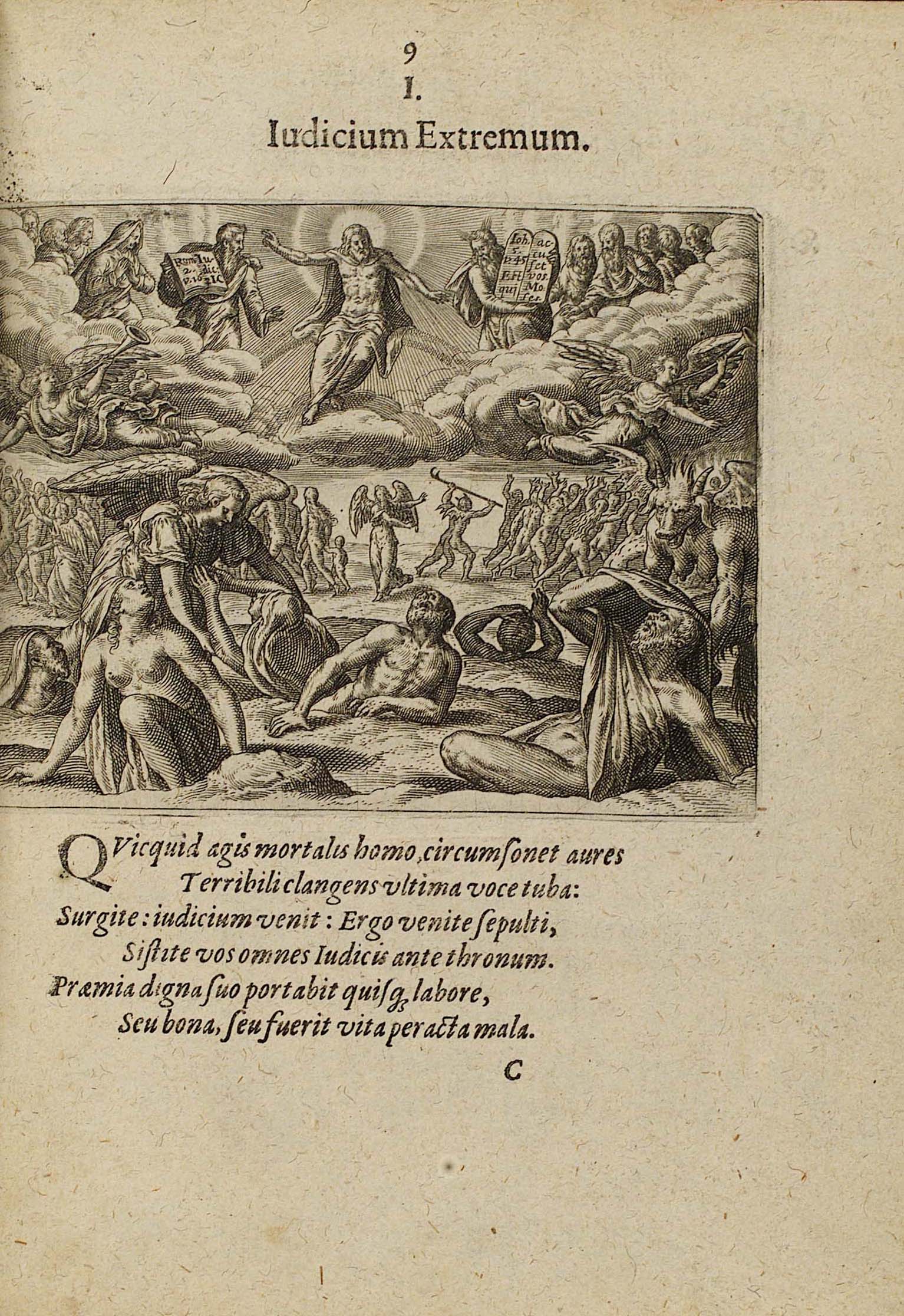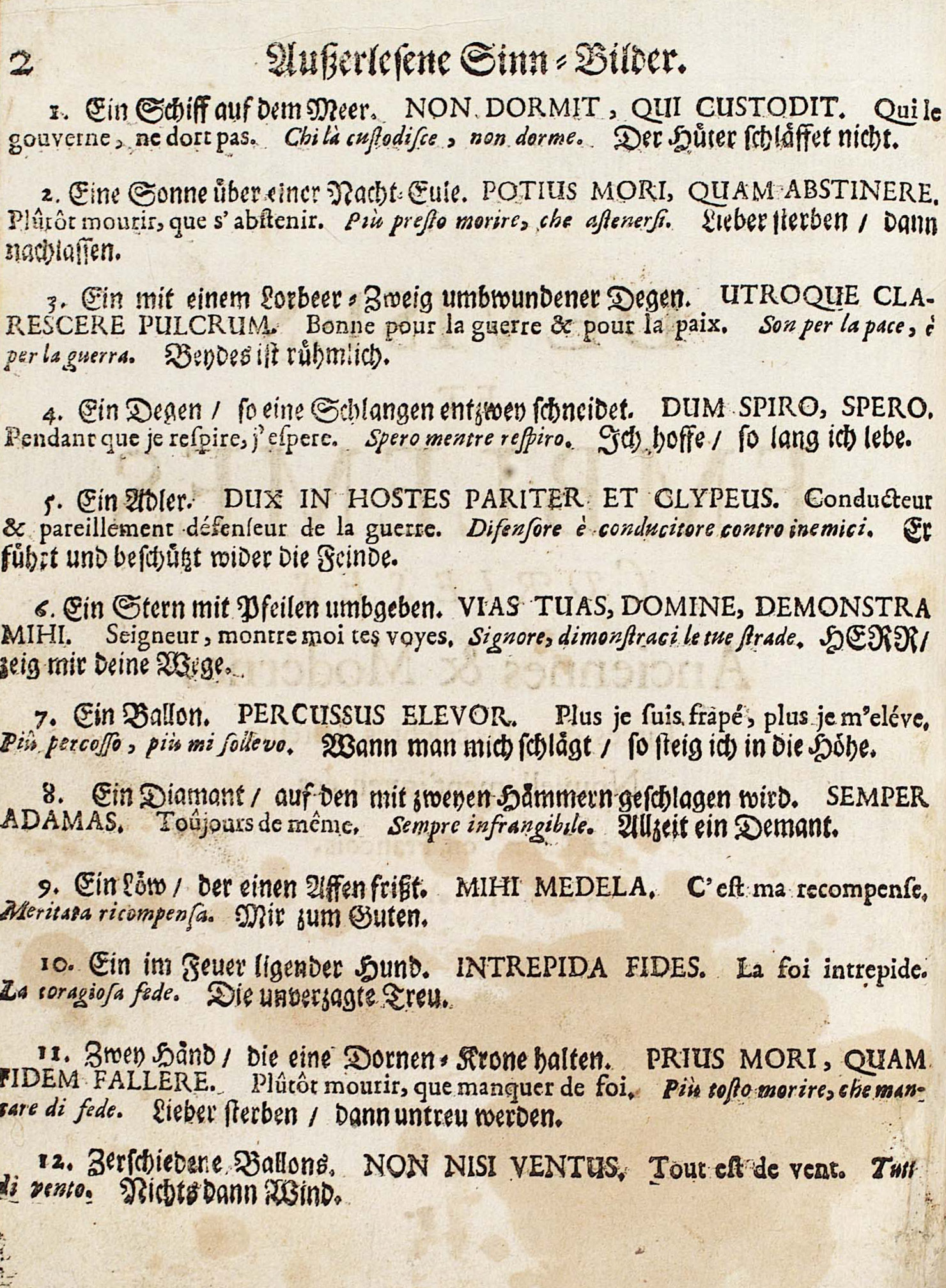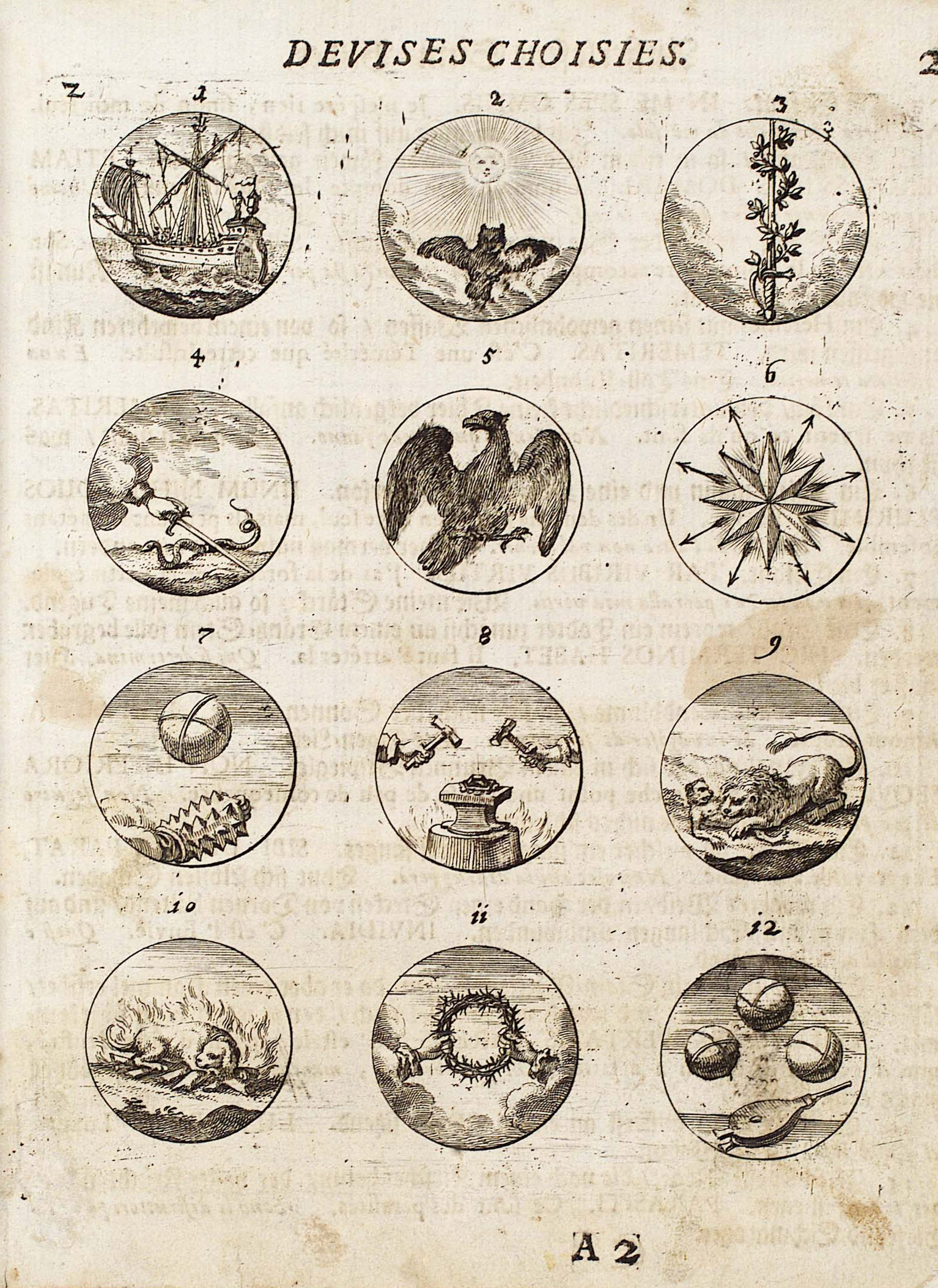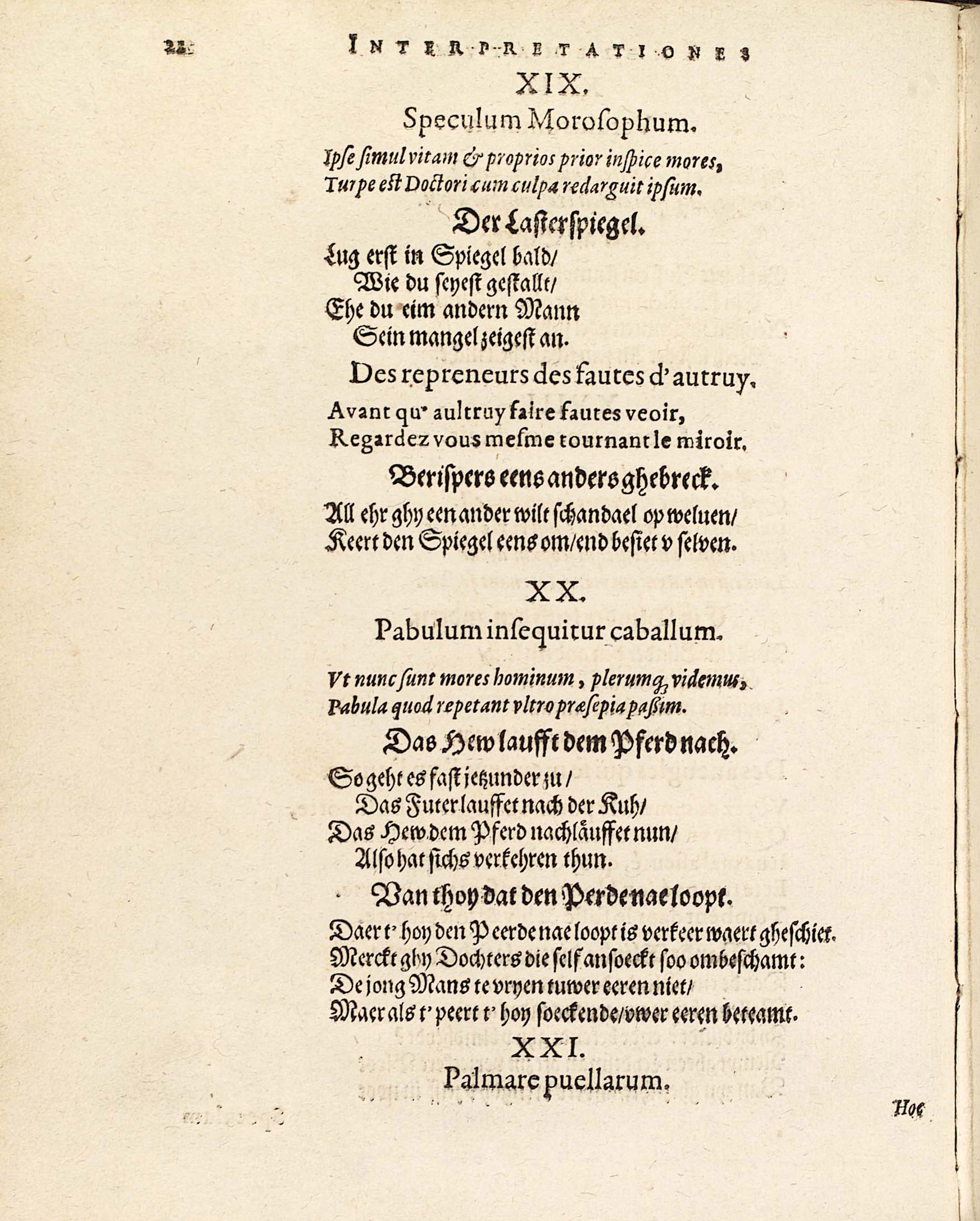
Practical Issues of the Wolfenbüttel Emblem Schema
Thomas Stäcker
Herzog August Bibliothek, Wolfenbüttel
staecker@hab.de
Stäcker, Thomas. "Practical Issues of the Wolfenbüttel Emblem Schema,"Emblem Digitization: Conducting Digital Research with Renaissance Texts and Images, ed. Mara R. Wade. Early Modern Literary Studies Special Issue 20 (2012): 6. <URL: http://purl.oclc.org/emls/si-20/WADE_Staecker_EMLS_Schema.htm>
1. Research on emblem books and emblems has profited greatly from the digitization and internet presentation of source materials. The University of Illinois[1] (hosting the OpenEmblem Portal), the University of Glasgow,[2] the University of Munich,[3] the Emblem Project Utrecht,[4] arkyves,[5] and the Herzog August Bibliothek (HAB), Wolfenbüttel,[6] to name just a few, have put selections of emblem collections online, to the effect that they can be searched and accessed much more easily than before. Digitization and presentation of substantial parts of digitized emblems on the web has made great progress in the last couple of years and the completion of major milestones are to be expected in projects such as the ongoing joint digitization project of the University of Illinois and the Herzog August Bibliothek.[7] However, the user and researcher still cannot be satisfied with having resources scattered all over the web and individual databases with proprietary conditions of use. Apparently, one of the great challenges of future digital emblem research and digital humanities in general is to achieve more integrated systems grouping resources together, making them available through uniformly designed graphical interfaces and allowing searches on standardized fields and vocabulary. This process can be long and tedious as there are not only technical obstacles to overcome, but also content-related, political, institutional and funding issues to solve.
2. The development of an XML-schema constitutes an important step in this process of sharing and disseminating resources for research on the web as it serves as a means to ensure integrity and consistency of metadata. This article a) discusses the significance of an emblem XML-schema, b) presents its core elements, c) deals with some practical issues and the question of data transformation, and d) outlines further developments and prospects.
a) The significance of an Emblem schema
3. The first moves toward more integrated solutions were made in Glasgow (2001), Palma de Mallorca (2001), La Coruña (2002), and above all Wolfenbüttel (2003). The participants of the Wolfenbüttel conference, which was financed by the Alexander von Humboldt foundation, agreed to work together more closely and started the OpenEmblem Group aimed at bringing together people and resources. One of the central demands at that time was to establish a common format or standard for indexing digital emblem material. Stephen Rawles’ so-called “spine of information” was discussed and adapted to the needs of the various projects and hence functions as a common standard. [8] It laid the foundation for the further development of technical tools allowing for more integrated access and harmonization of metadata.
4. It goes without saying that long before that conference XML was considered the core technique for data exchange, and many other techniques and applications hinge on XML, attesting to its ubiquity. The success and efficiency of XML compels us to investigate its applicability for the realm of emblem studies. It also does not make sense to re-invent or alter techniques that have been developed in other more influential scientific areas or by international operating software firms. As Greg Crane put it in his article, “Classics and the Computer: An End of the History”: “There should not be a history of classics and the computer, for the needs of classicists are simply not so distinctive as to warrant a separate ‘classical informatics.’” [9] We are even less entitled to speak of an “emblem informatics.” What should be our aim, however, is to make use of general informatics and XML in particular in such a way that emblem research can benefit from these techniques. The XML-schema is such a tool, allowing us to improve both our research and the metadata we are working on.
5. One of the most urgent requirements in transporting and exchanging emblem metadata was a shared standard, which thanks to the excellent work of Stephen Rawles seems to be established.[10]
6. The XML-schema we developed and which is available on project web page of Emblematica Online at the HAB is based on that standard and can be used to check the correctness and validity of a document structure and – to some extent - document content claiming to be in accordance with that standard.[11] In other words, the schema is meant to set the standard to work and enforce its rules in an XML environment. Indeed, there may be other realizations of the standard, for example when used in a database context or a traditional printed bibliography. The schema, therefore, should not be mistaken for the standard or vice versa. It checks if each element and attribute is in the right order and right place, controls content according to given patterns, and determines how often an element is allowed to be used, or if it is optional or required. But the schema does even more, and this is highly useful; it allows us to check documents automatically, in a process performed by software. As we strive for greater integration of emblem metadata and for databases which amass huge quantities of metadata derived from various electronic resources or other databases, it is crucial to have automatic checking mechanisms to ensure that databases have accurate data, integrity, and consistency.
b) Core elements
7. The following presents very briefly some core elements of the schema devised for Emblematica Online. It starts with the presupposition that a single, individual emblem is part of a corpus or container of emblems. As a rule, this container is a book that requires a bibliographic description, but it may also be an inventory of some sort, e.g. a file in an archive or a wall in a building.[12] The bibliographic description is meant to provide a short title description of the book. In describing bibliographic information it is sensible to take of advantage standards that are already well established. Thus the schema allows for the application of the well known Text Encoding Initative (TEI) header, the so called teiHeader,[13] and MODS, a widely accepted standard in the library community.[14] Other containers like church walls may have to be described differently.
8. The emblem pattern, subordinate to the container, consists of various elements, the most important among them are motto, pictura, subscriptio, iconclass notations, and the globalID attribute. I do not need to comment on this in great detail, as it becomes apparent in the example provided below, and will only demonstrate here the components of the motto, pictura and subscriptio. Texts of the motto and subscriptio may be described by a transcription, a normalized version of the transcription, a translation and keywords. The transcription element contains the given text. The normalization element serves to convey a normalized version of vernacular languages like archaic German, French, or Italian. This is helpful for present day users, who probably will apply modern vocabulary and orthography for their search. For the same purpose keywords may be added, preferably in English, at least as long as the web speaks English and not Chinese. Provision is made to capture translations, indicate sources, notes, names, and so forth. Additional attributes allow for indicating the language used in each field or attaching a URL to it. These are taken from standard XML namespaces (xmlns:xml, xmlns:link), e.g. xml:language and xml:href. Many more elements and attributes contained in this schema exist in addition to these but are not presented in full detail here. It is worth mentioning, however, that a couple of elements can be expanded by the TEI p-tag and its dependent components allowing a very sophisticated encoding of, for example, line and page breaks, abbreviations, annotations, names, etc.
9. There is a minimum restriction in the schema. It means that all elements are optional except a transcription of the motto. In other words, it was decided that an emblem description must at least contain a transcription of the motto in order to be valid (even if the motto is not present in the emblem there must be an empty element tag). The schema allows extending the description in great detail. In view of this it seems advisable to introduce definite levels of description. For example level 1 offers the motto only, level 2 provides the transcription of motto and some basic keywords of the picture, level 3 adds the transcription of the subscriptio and so forth. This flexible approach accommodates projects with varying degrees of depth and breadth.
10. The following shows an example of an emblem taken from Theodor de Bry’s Proscenium vitae encoded according to the schema. [15] The illustrations show the original. In illustration 1 the German motto and epigram can be seen:
[Illustration 1]
Illustration 2 on the next page of the book shows the Latin version and the picture:
[Illustration 2]
11. The motto, picture, and epigram would be encoded as can be seen here,[16] taking advantage of the p-extension of the TEI namespace[17]:
<emblem:emblem citeNo="1" xlink:href="http://diglib.hab.de/drucke/xb-6550/start.htm?image=00027" page="8v" globalID="http://hdl.handle.net/10111/EmblemRegistry: E014271" xml:id=" E014271">
< emblem:motto xml:id=" E014271_M1">
< emblem:transcription xml:lang="de" xlink:href="http://diglib.hab.de/drucke/xb-6550/start.htm?image=00027" page="8v">
Das Jungste Gericht.
< emblem:normalisation xml:lang="de">Das jüngste Gericht</ emblem:normalisation>
</ emblem:transcription>
</ emblem:motto>
< emblem:motto xml:id=" E014271_M2>
< emblem:transcription xml:lang="la" xlink:href="http://diglib.hab.de/drucke/xb-6550/start.htm?image=00028" page="9r">
Iudicium Extremum.
</ emblem:transcription>
< emblem:translation xml:lang="en">The last judgement</ emblem:translation>
</ emblem:motto>
< emblem:pictura xlink:href="http://diglib.hab.de/drucke/xb-6550/start.htm?image=00028" page="9r" medium="engraving">
<emblem:pictura xml:id="E014271_P1" xlink:href="http://diglib.hab.de/drucke/xb-6550/start.htm?image=00029" page="„ medium="engraving">
<emblem:iconclass rdf:about="http://iconclass.org/11U1">
<skos:notation>11U1</skos:notation>
<skos:prefLabel xml:lang="en">
Last jugdment
</skos:prefLabel>
</emblem:iconclass>
<emblem:iconclass rdf:about="http://iconclass.org/73F411(Rom. 2:16)">
<skos:notation>73F411(Rom. 2:16)</skos:notation>
<skos:prefLabel xml:lang="en">
Epistle of St. Paul the Romans
</skos:prefLabel>
</emblem:iconclass>
[etc...]
< emblem:keyword xml:lang="de" type="pictorial">Buch</keyword>
< emblem:keyword xml:lang="de" type="pictorial">Tafel</keyword>
< emblem:keyword xml:lang="de" type="pictorial">Jesus</keyword>
< emblem:keyword xml:lang="de" type="pictorial">Nimbus</keyword>
< emblem:keyword xml:lang="de" type="pictorial">Wolke</keyword>
< emblem:keyword xml:lang="de" type="pictorial">Engel</keyword>
< emblem:keyword xml:lang="de" type="pictorial">Posaune</keyword>
< emblem:keyword xml:lang="de" type="pictorial">Mann</keyword>
< emblem:keyword xml:lang="de" type="pictorial">Frau</keyword>
< emblem:keyword xml:lang="de" type="pictorial">Teufel</keyword>
< emblem:keyword xml:lang="de" type="pictorial">Mischwesen</keyword>
</ emblem:pictura>
<emblem:subscriptio xml:id=" E014271_S1>
< emblem:transcription xml:lang="de" xlink:href="http://diglib.hab.de/drucke/xb-6550/start.htm?image=00027" page="8v">
<tei:p> Mensch bedenck das letzt Gericht/<tei:lb/>
Wie dasselb werd außbleiben nicht/<tei:lb/>
Der letzt Posaunen schrecklich Stimm/<tei:lb/>
Dir allezeit zu Ohren nimm/<tei:lb/>
Steht auff jhr Todten alle gar/<tei:lb/>
Vnd stellt euch für den Richter dar/<tei:lb/>
Damit eim jeden Er vergelt/<tei:lb/>
Wie er gelebet in der Welt/<tei:lb/>
Es sey nun böß/ oder sey gut/<tei:lb/>
So findt sichs/ wenn man Rechnung thut.<tei:lb/>
</tei:p>
< emblem:normalisation>
<tei:p>O Mensch bedenke das letzte Gericht/<tei:lb/>
Wie dasselbe wird ausbleiben nicht/<tei:lb/>
Der letzten Posaune schreckliche Stimme/<tei:lb/>
Dir allezeit zu Ohren nimm/<tei:lb/>
Steht auf ihr Toten alle gar/<tei:lb/>
Und stellt euch für den Richter dar/<tei:lb/>
Damit einem jeden Er vergelt/<tei:lb/>
Wie er gelebet in der Welt/<tei:lb/>
Es sei nun böse/ oder sei gut/<tei:lb/>
So findet sichs/ wenn man Rechnung tut.<tei:lb/>
</tei:p>
</ emblem:normalisation>
</ emblem:transcription>
< emblem:transcription xml:lang="la" xlink:href="http://diglib.hab.de/drucke/xb-6550/start.htm?image=00028" page="9r">
<tei:p>
QVicquid agis mortalis homo, circumsonet aures<tei:lb/>
Terribili clangens vltima voce tuba<tei:lb/>
Surgite: iudicium venit: Ergo venite sepulti<tei:lb/>
Sistite vos omnes Iudicis ante thronum.<tei:lb/>
Praemia digna suo portabit <tei:expan>quisque</tei:expan> labore,<tei:lb/>
Seu bona, seu fuerit vita per acta mala.<tei:lb/>
</tei:p>
</ emblem:transcription>
</ emblem:subscriptio>
</ emblem:emblem>
Please note that the German and the Latin mottos are on different pages and linked to different images by URLs.
The globalID-attribute is noteworthy. This was introduced in the most recent version of the emblem schema allowing the unique identification of the emblem and its components. For that purpose a HANDLE service was set up at the University of Illinois serving to register each emblem in order to ensure its wordwide uniqueness. The introduction of the RDF:about attribute and SKOS namespace for the iconclass element and keywords is another important addition. As can be seen Iconclass notations can be used along with local keywords. Preference, however, is given to Iconclass as it is language independent and can be used in other contexts as well. For instance, Iconclass notations for Emblematica Online at the University of Illinois and Herzog August Bibliothek,Wolfenbüttel, are harvested by arkyves[18] and the Bildarchiv Foto Marburg[19] for inclusion in specialized art history databases.
c) Practical Issues and Transformations
12. The underlying concept of the emblem XML standard is the emblem. This sounds trivial, but it is not. There was a discussion at Wolfenbüttel whether the emblem book is to be included in the standard. But to my mind this would lead to various difficulties. Additionally, there is a much more efficient standard with TEI and the HAB has used it already for the bibliographic description. Thus one might ask why do we not use TEI for the emblem as well? First of all, a disadvantage of TEI is that it deals with texts only. Emblems, however, can also be found in other non-textual inventories or places, such as works of art, pictures, ceilings of churches and walls of buildings, and we would like to include these in the future as well.
13. The other disadvantage is that the concept of TEI – as we understand it - contradicts the idea of the emblem as defined for the schema. TEI, when used for transcription, is designed to encode text by pursuing the text sequence and structure mirroring or representing a given text basis. Emblems, in contrast, are conceived of as intellectual entities that may not be exactly represented in that given text. It may be necessary to collect parts of their structure from different locations in the text. The emblem of the last judgment from de Bry’s Proscenium vitae, for example, covers two different pages. According to the schema this is to be encoded by referring to the various pages by xml:href attributes as can be seen above. All parts of the emblem belonging together are nested in emblem, motto, or subscriptio tags.
14. It is an act of interpretation rather than description to constitute an emblem, and it is not the text’s sequence which is encoded here. An even more obvious example, can be seen in the “Emblematische Gemüths-Vergnügung”[20] from the edition of 1697,[21] with mottos in various languages on the left and medallions of the picturae belonging to them on the right (illustration 3).
[illustration 3]
[illustration 4]
15. In TEI this probably would be transcribed as follows:
<pb n=„2“/>
<p> 1. Ein Schiff auf dem Meer.
<seg type=„motto“ xml:lang=„la“ id=„e1la“>
NON DORMIT, QUI CUSTODIT.
</seg>
<seg type=„motto“ xml:lang=„fr“ id=„e1fr“>
Qui le gouverne, ne dort pas.
</seg>
<seg type=„motto“ xml:lang=„it“ id=„e1it“>
Chi là custodisce, non dorme.
</seg>
<seg type=„motto“ xml:lang=„la“ id=„e1“>
Der Hüter schläffet nicht.
</seg>
</p>
</div>
<pb n=„3“/>
<div type="pictura" corresp=„e1la e1fr e1it e1la"> etc.
<div>[22]
16. For example, TEI provides no way to nest the elements in an emblem tag, but requires instead indicating the interrelations of the emblem parts by pointers (“corresp”). Obviously, this is not a very elegant solution and the computer processing of that structure would be rather difficult because the parts being interconnected are not nested or grouped together. Other difficulties may arise when printed mottos deviate from engraved ones as can been seen e.g. in de Bry’s Emblemata Saecularia: [23]
[illustration 5]
[illustration 6]
17. Encoding tripartite emblems (dreiständige Embleme) is equally problematic. Other examples can be added. TEI offers a good means to transcribe or edit text, but causes difficulties when applied to the entity emblem.
18. This state of affairs has concrete, practical implications. In Wolfenbüttel we have decided to scan and index books rather than individual emblems and therefore apply TEI to encode the document structure of all of our digitized materials provided that there is structural metadata. If not, we must be content with recording the digital facsimile edition in the library catalogue and linking to the source.
19. This makes much more sense in a library context, where a book may also be used by people other than emblem specialists and for reasons other than studying emblems. As a consequence, the Wolfenbüttel TEI-XML structure cannot be used directly for the emblem exchange format, but requires some transformation. As can be seen from the examples presented here, this is difficult but not impossible since we have encoded the interrelations of the emblem parts and can retrieve them by XSLT-scripts. Again one may wonder why we did not use TEI for the emblem schema as it would have tremendously facilitated exports from our data. To demonstrate this, let me add another example from Munich. Dietmar Peil has devised a structure which reflects the distinction between emblem book and the individual emblem similar to that we proposed for the schema. There is no XML, but the data are contained in an Access database. Access permits downloading the data in XML. The result of the emblem table looks like this:
<Embleme>
<Intern_ID>49</Intern_ID>
<Embl_ID>emb_gemue_augsbu02001</Embl_ID>
<EmblBand_ID>3</EmblBand_ID>
<EmblBand_Kurztitel>Gemütsvergnügung</EmblBand_Kurztitel>
<Fundstelle>Taf. 02-01</Fundstelle>
<Pictura>Schiff</Pictura>
<Stichwort1>Schiff</Stichwort1>
<M-lat1>Non dormit, qui custodit</M-lat1>
<M-dt>Der Hüter schläffet nicht</M-dt>
<M-frz>Qui le gouverne, ne dort pas</M-frz>
<M-it>Chi là custodisce, non dorme</M-it>
<Quelle1>Typotius, 3,125e</Quelle1>
<Bild>img_gemue_augsbu00002</Bild>
</Embleme>
20. From here a seamless XSLT transformation with no structural problems can be performed. To transform this in a reasonable form of TEI is almost impossible. Thus, the emblem format is sufficiently malleable to capture data from data-oriented and not only document-oriented texts.
21. Another point I would like to emphasize is that TEI is not a very strict format. As might have been suspected from my earlier example, it allows for interpretation and variation. I am fairly certain that two encoders using TEI would not encode an emblem in the same way. This, for example, holds true for the Utrecht project. Utrecht used TEI, but created a new electronic document following the emblem structure, but not the text sequence. It is therefore not an encoding of the book, but of the emblems, akin to the emblem schema. This works to some extent, but, as shown above, leads to rather sophisticated encoding with many pointers necessary to group together the various emblem elements.
22. Thus, although there may be good reasons to adopt a TEI structure in a particular local context, it is less suitable for an emblem exchange format having to cover a broad variety of resources and applications. To my mind, it would be much more difficult to transform data from various resources into TEI than to convert them from TEI or other formats into the emblem standard. Even if we agreed on TEI, we would have to discuss its application for this particular purpose as the different approaches of Utrecht and Wolfenbüttel suggest.
23. Therefore, although it is preferable to adopt a general standard, it must be ensured that this standard matches the needs of the particular community. If no given standard serves the purpose or if the adaptation of that standard proves to be tricky, it is advisable to establish a new one. The emblem schema follows this line of argument. It assumes that a specific standard for the description of emblems serves the community best. Metadata from other resources, be they non-XML or other XML-formats, should be converted by standard tools like XML-Downloads and/or XSLT transformation into the emblem XML standard. The bibliographic description, however, can easily be encoded by using TEI, and the XML concept of namespaces allows the seamless integration of this part of the TEI:
<biblioDesc workID="drucke/xb-6550" xsi:schemaLocation="http://diglib.hab.de/rules/schema/emblem http://diglib.hab.de/rules/schema/emblem/emblem.xsd">
<tei:teiHeader>
<tei:fileDesc>
<tei:titleStmt>
<tei:title>
Proscenium vitæ humanæ siue Emblematvm Secvlarivm, Ivcvndissima, & artificiosissima varietate Vitæ Hvmanæ & seculi huius deprauati mores, ac studia peruersissima : Versibvs Latinis, Germanicis, Gallicis & Belgicis ita adumbrantium ... = Weltliche lustige newe Kunststück/ der jetzigen Welt Lauff farbildende/ mit artlichen Lateinischen Teutschen/ Frantzösischen vnd Niderländischen Carminibus vnd Reymen gezieret/ fast dienlich zu einem zierlichen Stamm vnd Wapenbüchlein / An Tag gegeben/ vnd in Kupffer gestochen Durch Joan. Theodorum de Bry : electronic edition
</tei:title>
<tei:author>Bry, Theodorum de</tei:author>
</tei:titleStmt>
<tei:publicationStmt><p>…</p></tei:publicationStmt>
<tei:sourceDesc><p>…</p></tei:sourceDesc>
</tei:fileDesc>
</tei:teiHeader>
<copyDesc xlink:href="http://diglib.hab.de/drucke/xb-6550/start.htm">
etc.
</copyDesc>
<emblem citeNo="1" xlink:href="http://diglib.hab.de/drucke/xb-6550/start.htm?image=00027" page="8v">
etc.
</emblem>
</biblioDesc>
24. Thus, irrespective of how data are encoded or stored, the standard offers a target format into which particular metadata can be converted. The advantage is that we have a specialized exchange format which can be neatly checked by the schema, thereby confirming the validity of elements to be integrated into a target database. It goes without saying that such a target emblem database amassing emblem data from various sources must comply with the schema’s rules.
d) Further developments and prospects
25. It is a fact that no schema can be expected to be complete and in the future we certainly will encounter several cases which cannot be captured by the schema. The Herzog August Bibliothek, Wolfenbüttel has developed a first draft, which was consolidated in the course of the last couple years by providing further features and refinements. Most important was the addition of a globalID attribute (see example above), allowing us to identify emblems and their components uniquely. Experience will be the best teacher, and we will strive to convert more data to verify the schema’s functionality. At the moment version 1.2. is available at the HAB web site. Next versions will follow that are designed to adapt it better to emblems coming from the material domain such as emblems on architecture, majolica, and paintings. Another important issue is to make the schema suitable for the semantic web by generating RDF compatible structures. A first step was taken in that direction by introducing the SKOS namespace into the emblem schema for the encoding of Iconclass notations and keywords. [24]
26. It is hoped that
the schema can contribute to better data integration and producing a common
database, preferably under the aegis of the OpenEmblem Portal, hosted at
the University of Illinois.[25]
In the meantime some applications were set up making use of the emblem
schema. There is an OAI interface at Herzog August Bibliothek, Wolfenbüttel[26]
where data compatible to the emblem standard can be harvested and an OAI
harvester at the University of Illinois. Surely many problems must still be
resolved, but I am confident that we will eventually succeed in building a
comprehensive joint database and/or access points for linked open data
structures so as to improve the availability and usability of our valuable
digital resources for emblem research and by the same token provide an
effective means for the growing digital humanities community.
Notes
[9] See Crane, p. 47
[10] See Rawles, p.19-29.
[12] Cf. Dietmar Peil, Die Embleme im Rittersaal auf Gut Hohen Luckow.
[20] See Peil who states “Die Augsburger 'Emblematische Gemüths-Vergnügung' ist eine kürzende Übersetzung einer Sammlung, die erstmals 1691 in Amsterdam von Daniel de La Feuille (ca. 1640-1709) unter Mitarbeit des als Sprachlehrer tätigen und als Verfasser deutsch-englischer Sprachbücher bekannten Heinrich Offelen herausgegeben worden ist.” Peil writes this in the introductory comments to the digital copy of this work at the Bavarian State Library, Munich.
http://mdz1.bib-bvb.de/~emblem/emblalle.html?inpKng=vtit&inpBegriff=3
[22] Apparently, there are much more ways to encode this, for instance, by typed divisions, but the encoding certainly will adhere to the same kind of idea of a continuous text.
[23] http://diglib.hab.de/drucke/22-1-eth/start.htm
By the way, the emblem’s picture appears 30 pages later in the book, and there is no explicit reference to this in the text.
Works Cited
- Crane, Greg: “Classics and the Computer. An End of the History,” in: A Companion to Digital Humanities, ed. Susan Schreibmann, Ray Siemens, John Unsworth. New York: Blackwells, 2004, p. 47. http://www.digitalhumanities.org/companion/
- Peil, Dietmar. “Introduction,” Emblematische Gemüths-Vergnügung bey betrachtung 715 der curieusten und ergözlichsten Sinnbildern mit ihren zuständigen Deutsch- Lateinisch-Französ- u[nd] Jtalienischen beyschrifften. Augsburg: Lorentz, 1693. http://mdz1.bib-bvb.de/~emblem/emblalle.html?inpKng=vtit&inpBegriff=3
- Peil, Dietmar. Gut Hohen Luckow - Die Embleme im Rittersaal. Hohen Luckow: Schloß Hohen Luckow Verlag, 2004.
- Rawles, Stephen. “A Spine of Information Headings for Emblem-Related Electronic Resources,” Digital Collections and the Management of Knowledge: Renaissance Emblem Literature as a Case Study for the Digitization of Rare Texts and Images, ed. Mara R. Wade. Salzburg: Digicult, 2004, pp. 19-29. http://www.digicult.info/pages/special.php
